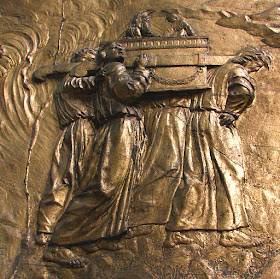The Ark of the Covenant is
the most sought-after lost “treasure” in history. Treasure
seekers as diverse as the Nazis and the fictional character of
Indiana Jones have tried to hunt down this priceless artifact. A
church in Ethiopia claims to own the Ark but won't let anyone see it.
What really happened to it is unknown—however, some intriguing
clues about the Ark's whereabouts dot the Biblical landscape.
In Exodus, God commanded
Moses to build a physical manifestation of Himself (God) to be
carried by the Israelites as they searched for a permanent homeland.
The Ark held the stone tablets inscribed with the Ten Commandments.
Constructed of acacia wood, and overlaid on the outside and inside
with gold, it had two gold-plated cherubim on the top. There were
also four rings of gold to hold wooden staves (also covered in gold)
so the Ark could be safely transported from place to place.
As related in Joshua 6, the
Ark was sometimes taken into battle. When attempting to capture the
heavily walled city of Jericho, the Israelites carried the Ark as
they marched around its walls. On the seventh day, they marched
around the city seven times, holding the Ark and blowing trumpets.
The walls collapsed, allowing Hebrew fighters to enter and capture
the city.
In 1st Samuel
5-6, the Ark was captured by the Philistines. This turned out to be
a disaster for these enemies of God. As soon as they brought the Ark
back to their territory, the Philistines suffered a series of
calamities similar to the plagues of Egypt. Finally, they had enough
and placed the Ark on two mules and sent it back to the Israelites.
Lea Speyer, in Israel
News, writes: “Eventually, the Ark came to rest in the First
Temple, which was built by King Solomon. The Ark was placed in a
special inner room known as the Holy of Holies, where the High Priest
would enter once a year on Yom Kippur. The Ark was last seen in 586
BCE when the Babylonians conquered Jerusalem and destroyed the First
Temple. What happened to the Ark
remains unknown until today.”
The Babylonian Empire may
have captured the Ark after the death of Solomon. 2nd
Kings 24: 13 states that “As the Lord declared, Nebuchadnezzar
removed the treasures from the temple of the Lord and from the royal
place, and cut up the gold articles that Solomon king of Israel had
made for the temple of the Lord.”
Did Nebuchadnezzar take the
Ark? Was it among the “gold articles” he captured and cut up?
(Solomon did not make the Ark, and the scripture is clear that the
articles taken by Nebuchadnezzar were “made” by Solomon.)
Could the Ark have been
spirited away to keep the Babylonians from capturing it? It wouldn't
be the first time the Israelites hid sacred objects from approaching
armies. (The Dead Sea scrolls are just one example.) A book of Jewish history, the 2nd Maccabees, claims the Ark
was moved to Mount Nebo by the prophet Jeremiah. There he placed it
in a cave and walled up the entrance. When a group of Israelites
attempted to find it, he informed them it would stay sealed up until
the end of time.
Another theory asserts that
the Ark was buried beneath the temple where it lies to this day. A
writer in National Geographic magazine wrote: “[One] claim is that
the Ark was hidden in a warren of passages beneath the First Temple
in Jerusalem before the Babylonians destroyed it in 586 B.C. But
that theory can't be tested...because the site is home to the Dome of
the Rock shrine, sacred in Islam. Digging beneath it simply isn't an
option.”
If the Babylonians took the
Ark, why didn't it work its supernatural powers on them like it did
on the Philistines? Did God, fed up with the continual
transgressions of His people, allow the Ark to be destroyed?
Endless theories abound.
One thing is certain: if the Ark of the Covenant is ever discovered,
it will surpass even the tomb of Tutankhamen as the greatest
archaeological find ever.


No comments:
Post a Comment